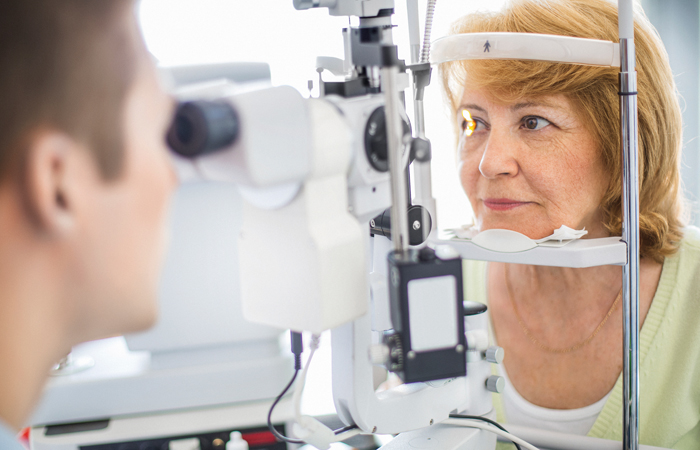In focus
In OTC
Follow this topic
Bookmark
Record learning outcomes
The eyes are delicate organs that are susceptible to a range of conditions that can be picked up during a routine eye exam, but people aren’t going as often as recommended
Almost a quarter of adults say they can’t see as well as they used to, but haven’t sought advice, according to the new State of the Nation Eye Health 2017 report from the Royal National Institute of Blind People (RNIB) and Specsavers.

The NHS recommends that adults and children over three years have an eye test at least every two years, although certain people should go to their optometrist more frequently, such as those over 40, those with a family history of eye conditions and people of Afro-Caribbean or Asian origin.
Many people think that a sight test is just about checking vision, but it can also pick up general problems with the eyes – and even with overall health. According to the report, while 80 per cent of those asked expected a high street optometrist to be checking for eye health conditions, only 27 per cent expected their general health to be covered within the appointment. More than 80 per cent were unaware that an eye test can detect signs of cardiovascular disease.
Health benefits
Almost four in five people who are living with sight loss in the UK are aged 65 and over, and it’s believed that around half of these cases could have been prevented. With some of the most common causes of sight loss, such as glaucoma, cataracts and age-related macular degeneration (AMD), early detection and diagnosis is crucial.
“If some eye problems are diagnosed early, it’s possible to reduce the risk of permanent sight loss,” says Louise Gow, specialist lead for eye health at the RNIB. “With glaucoma, for example, people don’t even know they have the condition during the early stages and once the symptoms appear, sight loss is already established. Glaucoma can’t be cured but it can be controlled, so needs to be picked up early on. Cataracts can affect anyone but can be picked up in a routine examination before any vision is lost. Age-related macular degeneration is the most common cause of sight loss in the over-65s. OCT (optical coherence tomography) retinal imaging means the earliest signs can be spotted by optometrists, who can then refer for treatment and give advice on diet and lifestyle issues.”
It’s not just serious eye conditions causing sight loss. Refractive errors, such as short-sightedness, long-sightedness and astigmatism, account for around 39 per cent of those living with sight loss in the UK. This means that thousands of people would notice a vast improvement by wearing prescribed glasses or contact lenses.
“Regular checks are important as we can prevent any development of visual stress and eyestrain due to inaccuracies and/or change in spectacle prescriptions,” says Sona Thakerar, optometrist at Aston & Woods opticians, London. “We also check for any eye muscle anomalies that can lead to eye strain and diagnose and manage dry eyes, which is a very common eye condition.”
An eye test can detect signs of general health problems as well. “When an optometrist does an eye check, they look at the back of the eye and can see blood vessels in real life,” says Louise. “This shows a person’s general health, such as thinning of their blood vessels or arteries pressing on the veins, which could suggest high blood pressure or show changes associated with diabetes. There are certain neurological problems that could be picked up as well, such as damage to the top of the optic nerve in multiple sclerosis. Some medicines have an impact on eyes, such as steroids, antimalarials, tamoxifen and arthritis medicines, so anyone taking these should have regular eye checks.”
Changing preconceptions
In 2017, Specsavers conducted research to understand the perceived barriers to visiting an optometrist. They found that 33 per cent of people didn’t go to an optometrist as they didn’t think there was anything wrong with their eyes, 24 per cent said that they didn’t have time or didn’t get round to it (despite the average appointment only taking around 20 to 30 minutes) and 17 per cent were concerned about the cost of new glasses (even though the NHS provides financial support to those who need it). Many optometrists also say that some people worry about how they will look in glasses so don’t want to wear them.
Most chronic eye conditions don’t cause pain in the early stages – if at all – so people assume that if they can see relatively well then there’s nothing wrong with their vision. In the Specsavers research, people who hadn’t been to an optometrist in the past two years said they would go if they were struggling to read, see their mobile phone, tablet or computer, or if they were starting to get headaches or tired eyes.
Some people believe that if they’re prescribed glasses, their eyes will worsen if they wear them regularly. But Louise says it’s natural changes in the eyes that worsen vision, so a better understanding of long-sightedness would help. “Some people are genuinely unaware of how bad their vision is,” she says. “Pharmacies selling ready readers should discuss with the person purchasing them whether they should have an eye examination too – ready readers should not replace the eye examination.”
Sight tests should be part of everyone’s healthcare routine, just like going to the dentist, whatever their age, but this often isn’t the case. “A lot of parents don’t like children wearing glasses, but children don’t necessarily know when their vision isn’t as good as it should be,” says Louise. “This is important as issues that affect the focusing of a child’s eyes will cause permanently reduced vision and 3D vision if not treated by the age of eight years. Often parents are unaware that their child has a lazy eye as not all lazy eyes cause an eye turn. Only an eye examination will be able to pick up some forms of lazy eye so that they can be treated.”

Raising awareness
During National Eye Health Week 2018 (24 to 30 September), the RNIB and Specsavers are warning people to seek immediate advice from their optometrist if they start to experience problems with their eyes, so that potential conditions can be detected, diagnosed and treated before it’s too late. In Specsavers’ research, more than half of adults said they would go to their GP if they woke with an eye problem tomorrow. However, they can also visit an optometrist to diagnose and treat eye complaints.
Until recently, minor eye conditions have been treated by visits to GPs, pharmacists or A&E. However, in some areas, a new Minor Eye Conditions Service (MECS) enables optometrists to see patients for a non sight test-related examination under the NHS. Patients who present with a red eye or flashes and floaters would otherwise have been sent to A&E or charged privately.
Community pharmacy can play an important role in eye care. “Pharmacists are ideally placed to mention general eye health, such as smoking cessation advice during a medicines use review (MUR), discussing how smoking affects the eyes,” says Sandra Gidley, chair of the Royal Pharmaceutical Society’s English Pharmacy Board. “During a targeted MUR to diabetes patients, they often give lifestyle advice but may not necessarily think enough about the increased risk of eye problems and the importance of annual checks. The pharmacy team should always refer customers to the pharmacist if they’re unsure about eye symptoms. Eye pain or disturbances of vision could be a sign of something else and should always be checked out.”
Louise also suggests that pharmacists speak to customers with eye-related symptoms, or anything that could impact on their eyes, such as diabetes. “People with diabetes can be more prone to cataracts, dry eyes, changes in prescriptions, infections and glaucoma. If optometrists can see a problem during a routine health check, they can flag up whether diabetes management needs to be reviewed by sending patients back to their pharmacist or GP.”
Common eye problems
Conjunctivitis
Conjunctivitis can be caused by irritation, an allergy or an infection. Common symptoms include red, bloodshot, watery eyes, inflamed inner eyelids, blurred vision, a scratchy feeling and discharge. Watery discharge is more likely to be caused by a virus or allergy, whereas sticky discharge (especially on waking) is more likely to be a bacterial infection. If the cause is unclear, customers should consult an optometrist. Conjunctivitis usually clears up on its own without any treatment. Viral conjunctivitis symptoms may be eased with artificial tears, simple painkillers and good eye hygiene, whereas bacterial conjunctivitis can usually be treated with over-the-counter chloramphenicol eye drops as a first-line option. Allergic conjunctivitis usually clears up with antihistamine or sodium cromoglicate eye drops. Customers should be advised to clean their eyes with cotton wool soaked in cooled boiled water (one piece for each eye) to remove any crusts or sticky discharge. It’s important to stop any infection from spreading by washing hands regularly.
Dry eye
Dry eyes either don’t produce enough tears or the tears evaporate too quickly. If the eyes dry out, this can cause itching, inflammation and irritation (a feeling of dust in the eye). Severe untreated dry eyes can damage the cornea, leading to scarring.
Dry eyes are particularly common in people over 65 years of age, menopausal women and contact lenses wearers. They may also be associated with certain medical conditions, such as diabetes or arthritis and some medicines (e.g. antidepressants), as well as environmental factors, such as air conditioning, computer work or central heating.
Mild to moderate cases of dry eye syndrome can usually be treated with over-the-counter eye drops, gels and ointments containing tear substitutes. Customers can also buy dry eye sprays to use on their closed eyelids. Useful tips include using a warm compress on the eyes to trigger tear production (either a warm flannel or ready-made warming eye products), blinking more often while reading or using the computer and avoiding hot, dusty, dry or smoky environments.
Blepharitis
Blepharitis (inflammation of the eyelids) is due to blocked or infected glands around the eyelashes. It causes itchy, swollen and sore eyelids, eyelids that stick together and crusty or greasy eyelashes. It’s usually a chronic condition and can be associated with dandruff. Good eye hygiene can prevent and manage blepharitis. Customers can use a warm compress to make oils in the eye more runny and then clean their lids with warm water or specific blepharitis products. Gently massaging the eyelids may also help. If the blepharitis causes dryness, they can buy oily lubricants (such as gel or drops) over the counter. Persistent cases may require prescribed topical or oral antibiotics.
Styes
A stye is a small, red lump on an eyelid, usually beginning as a tender area at the base of an eyelash. It’s caused by an infection of the eyelid glands, although is rarely serious. Most styes get better on their own within a few days or weeks without any treatment. Alternating warm and cold compresses held against the eye for five to 10 minutes at a time, three or four times a day, will encourage the stye to release pus and heal more quickly. Customers can use painkillers if they experience pain, but if the stye is very painful or swollen and isn’t getting better, customers should be advised to see their GP. A GP may drain the stye, remove the eyelash nearest to the stye or refer patients to an eye specialist. Customers should never try to burst a stye themselves.
Most chronic eye conditions don’t cause pain in the early stages – if at all
